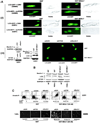The development of MDA-7/IL-24 as a cancer therapeutic
- PMID: 20732354
- PMCID: PMC2947573
- DOI: 10.1016/j.pharmthera.2010.08.001
The development of MDA-7/IL-24 as a cancer therapeutic
Abstract
The cytokine melanoma differentiation associated gene 7 (mda-7) was identified by subtractive hybridization as a protein whose expression increased during the induction of terminal differentiation, and that was either not expressed or was present at low levels in tumor cells compared to non-transformed cells. Based on conserved structure, chromosomal location and cytokine-like properties, MDA-7, was classified as a member of the interleukin (IL)-10 gene family and designated as MDA-7/IL-24. Multiple studies have demonstrated that expression of MDA-7/IL-24 in a wide variety of tumor cell types, but not in corresponding equivalent non-transformed cells, causes their growth arrest and rapid cell death. In addition, MDA-7/IL-24 has been noted to radiosensitize tumor cells which in part is due to the generation of reactive oxygen species (ROS) and ceramide that cause endoplasmic reticulum stress and suppress protein translation. Phase I clinical trial data has shown that a recombinant adenovirus expressing MDA-7/IL-24 (Ad.mda-7 (INGN-241)) was safe and had measurable tumoricidal effects in over 40% of patients, strongly arguing that MDA-7/IL-24 could have significant therapeutic value. This review describes what is presently known about the impact of MDA-7/IL-24 on tumor cell biology and its potential therapeutic applications.
Copyright © 2010 Elsevier Inc. All rights reserved.
Figures



References
-
- Bursch W. The autophagosomal ± lysosomal compartment in programmed cell death. Cell Death and Differ. 2001;8:569–581. - PubMed
-
- Caudell EG, Mumm JB, Poindexter N, Ekmekcioglu S, Mhashilkar AM, Yang XH, et al. The protein product of the tumor suppressor gene, melanoma differentiation-associated gene 7, exhibits immunostimulatory activity and is designated IL-24. J Immunol. 2002;168:6041–6046. - PubMed
-
- Chada S, Mhashilkar AM, Ramesh R, Mumm JB, Sutton RB, Bocangel D, et al. Bystander activity of Ad-mda7: human MDA-7 protein kills melanoma cells via an IL-20 receptor-dependent but STAT3-independent mechanism. Mol Ther. 2004a;10:1085–1095. - PubMed
-
- Chada S, Sutton RB, Ekmekcioglu S, Ellerhorst J, Mumm JB, Leitner WW, et al. MDA-7/IL-24 is a unique cytokine-tumor suppressor in the IL-10 family. Int Immunopharmacol. 2004b;4:649–667. - PubMed
Publication types
MeSH terms
Substances
Grants and funding
- R01 CA108520/CA/NCI NIH HHS/United States
- P01-NS031492/NS/NINDS NIH HHS/United States
- R01 CA127641/CA/NCI NIH HHS/United States
- R01-CA077141/CA/NCI NIH HHS/United States
- R01 CA063753/CA/NCI NIH HHS/United States
- R01-DK52825/DK/NIDDK NIH HHS/United States
- R01 CA141703/CA/NCI NIH HHS/United States
- P01 CA104177/CA/NCI NIH HHS/United States
- R01 CA129111/CA/NCI NIH HHS/United States
- R01 CA098712/CA/NCI NIH HHS/United States
- P01-CA104177/CA/NCI NIH HHS/United States
- P01 NS031492/NS/NINDS NIH HHS/United States
- R01-CA098712/CA/NCI NIH HHS/United States
- R01-CA127641/CA/NCI NIH HHS/United States
- R01 CA122930/CA/NCI NIH HHS/United States
- R01 CA097318/CA/NCI NIH HHS/United States
- R01-CA108325/CA/NCI NIH HHS/United States
- R01-CA063753/CA/NCI NIH HHS/United States
- R01 DK052825/DK/NIDDK NIH HHS/United States
- R01-CA097318/CA/NCI NIH HHS/United States
- R01 CA150214/CA/NCI NIH HHS/United States
- R01 CA138587/CA/NCI NIH HHS/United States
LinkOut - more resources
Full Text Sources
Other Literature Sources
Medical

